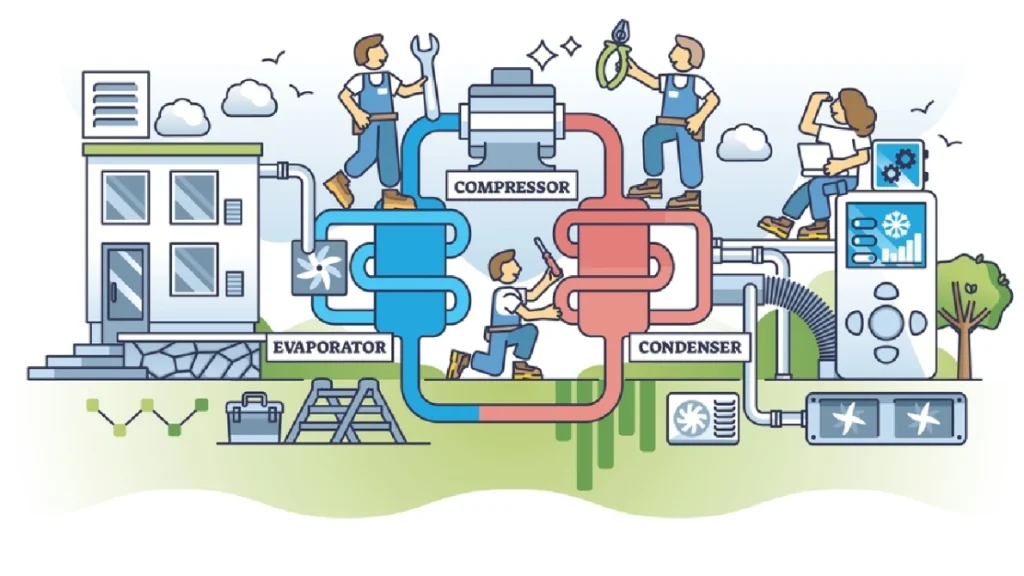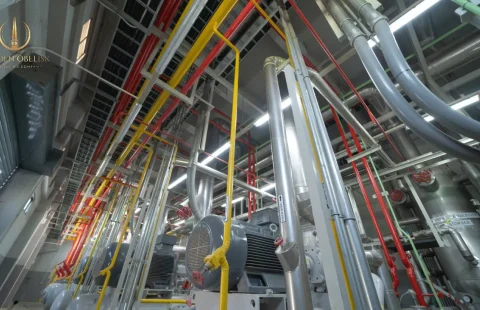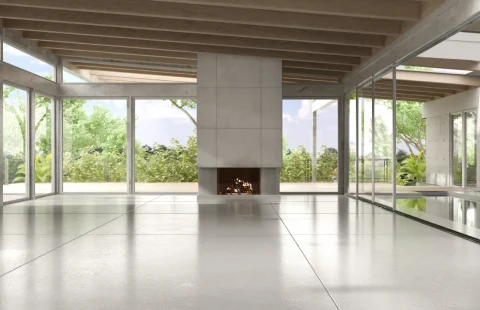
What Is HVAC and How Does an HVAC System Work?
What is HVAC?
HVAC, an acronym for Heating, Ventilation, and Air Conditioning, represents the technology used to regulate indoor environments in both residential and commercial settings. This system is crucial for maintaining comfort by managing temperature, humidity, and air quality. HVAC systems function by either heating or cooling the air, and they often include mechanisms for filtering and improving air quality by removing contaminants like bacteria and spores.
The range of HVAC solutions is broad, including central air conditioning units, furnaces, and ductless mini-splits, each designed to suit various needs and preferences.
In addition to managing climate control in homes, HVAC systems play a significant role in more specialized environments, such as data centers. These facilities require meticulous planning to meet the environmental needs of IT equipment, which includes precise temperature and humidity control.
Effective HVAC solutions in data centers might involve redundant systems and backup hvac components to ensure uninterrupted operation and safeguard against environmental failures. Proper implementation and maintenance are essential to keep these systems functioning optimally and to
What does HVAC mean?
An HVAC system manages indoor climate by heating, cooling, and ventilating air to maintain a comfortable environment in various buildings. It consists of multiple components such as air conditioners, furnaces, and heat pumps, which can be separate or combined depending on the setup. Additionally, these systems often feature air filters to improve indoor air quality by removing particles and humidity control devices like humidifiers and dehumidifiers to ensure optimal comfort.
HVAC systems work by circulating air through ducts or directly into rooms using different methods, depending on the system design. Central systems typically involve a central unit and ductwork to distribute treated air throughout a building, while ductless systems like mini-splits deliver air directly to specific areas. Modern advancements have introduced automation and smart technology, enhancing system efficiency and control through apps and programmable thermostats.
How Does an HVAC System Work?

How Forced-Air HVAC Systems Work
Forced-air HVAC systems are the most common type used in residential and commercial settings. These systems include a central unit that treats the air, which is then circulated throughout the building via ductwork. The system’s blower pushes the conditioned air into various rooms, providing consistent heating or cooling.
Central Air Conditioning Systems
In central air conditioning systems, the air is treated by a central unit, which cools or heats it as necessary. The treated air is then distributed through a network of ducts that deliver it to different parts of the building. This type of system is ideal for larger buildings where consistent temperature control is needed across multiple rooms or zones.
Ductless HVAC Systems
Ductless systems, such as mini-splits, operate without the need for ductwork. These systems have individual units installed in different rooms or zones, allowing for customized temperature control in each area. Ductless systems are particularly useful in homes where duct installation is impractical or where different areas require different levels of heating or cooling.
Air Filtration and Quality Control
As air circulates through an HVAC system, it often passes through filters designed to remove allergens, dust, and other airborne particles. This filtration process is crucial for maintaining good indoor air quality, especially in homes with allergy sufferers or in areas with high levels of pollution.
Combined HVAC Systems
Many homes use combined HVAC systems, where heating and air conditioning are integrated into a single system. This typically involves a central blower that circulates air through internal ducts, providing both heating and cooling as needed. Some homes may also use a combination of radiant heating systems and window air conditioning units, though this setup is less common.
HVAC System Basics
Heating, Ventilation, and Air Conditioning (HVAC) systems are crucial for maintaining indoor air quality and ensuring comfort in buildings. They do more than just heating or cooling; they also play a significant role in ventilating and purifying the air.
Components of an HVAC System
1. Air Ducts:
Ductwork is the network of tubes running through a building’s walls and ceilings, carrying warm or cool air from the HVAC unit to different areas. Ducts must be sealed and insulated to maximize energy efficiency. They connect to HVAC units via plenums—one for supply and one for return airflow.
2. Air Handlers:
An air handler is the indoor component responsible for moving conditioned air throughout the building. It includes a blower motor and fan that circulate air and contains evaporator coils in AC systems, which cool the air.
3. Condensers:
The condenser, located outdoors, functions as a heat exchanger for the refrigerant. It releases heat from the refrigerant into the outside air and includes a compressor that prepares the refrigerant for cooling more air.
4. Humidifiers and Dehumidifiers:
These devices regulate indoor humidity. Humidifiers add moisture to the air, while dehumidifiers remove it, which is crucial in climates that are too dry or humid.
5. Refrigerant:
Refrigerant is the liquid that transfers heat from one place to another within the HVAC system. It pulls heat from indoor air and releases it outside, cooling the indoor environment.
6. Thermostat:
The thermostat controls the HVAC system, maintaining the desired temperature by turning the system on and off as needed.
7. Vents:
Vents connect ductwork to the building’s interior or exterior, ensuring proper airflow and fresh air intake.
HVAC System Functions
1. Ventilation:
HVAC systems start with ventilation, bringing in fresh air from outside or inside the building. This can occur naturally, through windows and doors, or mechanically, using a system designed to move air in and out.
2. Air Handling:
Once air is drawn in, it passes through filters to remove contaminants. The filtered air is then conditioned—heated, cooled, and/or dehumidified—to achieve the desired indoor climate.
3. Air Distribution:
In central systems, the conditioned air travels through ducts to different rooms. In other systems, air is directed straight into the space, ensuring a comfortable indoor environment.
Importance of HVAC Systems
HVAC systems are essential for maintaining a healthy and comfortable indoor environment. They provide proper ventilation, regulate temperature, control humidity, and filter out pollutants, ensuring that the air quality inside buildings is optimal for occupants.
Types of HVAC System
Different types of hvac system exits. Let’s start discussion about these types and which one is best for your residitional and commercials use.
Split System HVAC
The split system is a prevalent choice for residential heating and cooling, featuring both an outdoor unit and an indoor unit. It typically includes a combination of a heat pump or air conditioner outside and a furnace or air handler inside. This system is ideal for homes where space and efficiency are key factors.
Dual Fuel Heat Pump System
A dual-fuel heat pump system merges an electric heat pump with a gas furnace to handle both heating and cooling. The heat pump operates during milder weather, while the furnace kicks in when temperatures drop below a certain point. This hybrid approach maximizes efficiency and comfort across varying climates.
Ductless Mini-Split System
Ductless mini-split systems are suitable for homes lacking ductwork, featuring an outdoor unit and one or more indoor air handlers. They offer flexibility by allowing each unit to be controlled independently. These systems are particularly useful for retrofitting older homes or individual rooms needing climate control.
Packaged System
A packaged HVAC system integrates all components into a single outdoor unit, ideal for homes with limited interior space. This system includes options like gas/electric, heat pump, and dual-fuel configurations. It is a practical choice for smaller homes or buildings where indoor space is at a premium.
Boiler System
The boiler system uses water or steam to distribute heat through radiators or pipes, providing consistent warmth. Boilers can run on various fuels such as natural gas, oil, or electricity. This system is effective for buildings that need steady and reliable heating.
Central Air Conditioning
Central air conditioning systems require both an indoor air handler and an outdoor compressor. They are highly efficient and powerful but necessitate existing ductwork, making installation costly for homes without it. This system excels in cooling large areas efficiently.
Mini-Splits
Mini-split systems feature an outdoor condenser and multiple indoor air handlers, providing targeted cooling without the need for ducts. They are versatile and customizable, ideal for homes with specific cooling needs or those without existing ductwork. These systems offer an aesthetic advantage as well.
Radiant Heating
Radiant heating systems warm a home’s floors or walls directly, using hot water or electric cables. This method is energy-efficient and reduces air movement, which minimizes allergens. Although effective, it can be challenging to install, particularly in homes not originally designed for it.
Core HVAC Components
An HVAC system comprises various components working together to provide indoor comfort. Understanding these elements is crucial for maintaining efficiency and performance.
Air Conditioner
Air conditioners are essential for cooling your home by transferring heat from the indoor air to the outside. They come in different configurations such as single-stage, two-stage, and variable-speed systems, suitable for varying climates and comfort needs.
Heat Pump
Heat pumps are versatile units capable of both heating and cooling. They operate by moving refrigerant to absorb and release heat, offering a more energy-efficient alternative to traditional fuel-burning systems.
Furnace
Furnaces generate heat by burning fuel like natural gas or propane. They then distribute this heat throughout the home via ductwork. Furnaces are available in single-stage, two-stage, and modulating models, each offering different levels of efficiency and control.
Air Handler
The air handler circulates conditioned air throughout your home, often paired with a heat pump or air conditioner. It ensures that every room reaches the desired temperature by moving air through the ductwork or directly into rooms.
Ductwork
Ductwork consists of metal or flexible pipes that transport conditioned air from HVAC units to various parts of the home. Properly installed and maintained ducts are crucial for effective air distribution and energy efficiency.
Humidifier and Dehumidifier
Humidifiers and dehumidifiers help manage indoor humidity levels. Humidifiers add moisture to the air in dry conditions, while dehumidifiers remove excess moisture, enhancing comfort and air quality.
Whole-House Air Cleaners
Whole-house air cleaners improve indoor air quality by filtering out allergens, pollutants, and microorganisms from the air before it circulates through the HVAC system. They offer a more comprehensive solution than standard filters.
Whole-House Ventilation
Whole-house ventilation systems ensure a steady exchange of indoor air with fresh outdoor air. This is especially beneficial for well-insulated homes where natural ventilation is limited.
Thermostat
The thermostat controls the HVAC system’s operation, setting and adjusting indoor temperatures based on user input. Modern smart thermostats offer advanced features like remote access, scheduling, and energy usage monitoring.
Additional Components
Other components in an HVAC system include air filtration systems, humidification and dehumidification equipment, and cooling towers. These elements contribute to maintaining optimal air quality and comfort.
Introduction to HVAC System Installation
Installing an HVAC system is a complex task that requires professional expertise. Whether it’s a central heating and air system or a ductless mini-split system, the process involves various technical steps and legal requirements. Attempting to install an HVAC system on your own can lead to warranty issues, safety risks, and potential legal violations.
Importance of Hiring Licensed HVAC Professionals
HVAC system installation should always be handled by licensed professionals. Local building codes often mandate professional installation, and attempting a DIY installation could void your system’s warranty. Licensed HVAC technicians have the necessary skills and certifications to ensure the installation is done correctly and safely.
The HVAC Installation Process
The installation process varies depending on the type of HVAC system being installed. For a central heating and air system, the process may include:
- Sealing or installing new ductwork
- Properly venting a gas furnace
- Hooking up refrigerant lines
- Refrigerant charging
- Performing electrical work
For a ductless mini-split system, the installation involves:
- Mounting indoor units on the wall, ceiling, or floor level
- Installing the outdoor unit
- Running refrigerant conduits between the indoor and outdoor units
Legal and Environmental Considerations
Removing refrigerant from an old HVAC system requires a special Environmental Protection Agency (EPA) certification. This step is crucial to ensure compliance with environmental regulations and avoid legal issues. Homeowners without proper licensing are not legally allowed to perform most HVAC installation tasks.
Steps Involved in HVAC System Installation
- Consultation and Estimate: The process begins with a consultation with an HVAC installation company to determine the best system for your home. You’ll receive an estimate covering all costs associated with the installation.
- Disconnecting the Fuel Source: The technician will turn off the electricity, gas, or oil flow to the existing system to safely begin the removal process.
- Removing Refrigerant: All refrigerant is carefully removed from the system to comply with environmental regulations.
- Ductwork Repair or Replacement: Any necessary ductwork repairs or replacements are completed before installing the new system.
- Removing Old Components: The old HVAC system components, such as the main unit, condenser, evaporator coils, and compressor, are removed.
- Installing the New System: The new HVAC system is installed, including any additional components like air purifiers, humidifiers, or dehumidifiers.
Timeline for HVAC Installation
In most cases, the entire HVAC installation process can be completed within a single day, barring any major repair work. However, the complexity of the installation and any additional work required can impact the timeline.
Tips for Choosing an HVAC Company
Selecting the right HVAC company requires careful consideration to ensure that you receive quality service and reliable support. Start by verifying that the company offers the HVAC brand you prefer, as compatibility is crucial for optimal performance. It’s important to confirm that the technicians are both licensed and insured. A valid license indicates that the technicians are knowledgeable about local regulations and safety standards, while insurance protects you from potential liabilities during the installation or repair process.
Certifications can further distinguish a qualified technician. Look for contractors certified by reputable organizations like North American Technician Excellence (NATE). These certifications represent a higher level of expertise, as they involve passing rigorous exams that cover comprehensive HVAC knowledge. Additionally, checking the company’s reviews and asking for references can provide insight into their service quality and reliability. Pay attention to recurring issues in reviews and directly inquire with past clients to gauge satisfaction levels.
An in-person quote is essential for a precise understanding of the costs involved. A technician should evaluate your home’s layout and specific needs before providing a detailed estimate. This personalized approach helps in assessing the true cost of the installation or repair based on your unique circumstances. Ensure that you receive itemized proposals in writing, specifying the scope of work and associated costs for transparency.
Lastly, comparing costs and warranties is vital. Opting for the cheapest option may not always be the best choice if it results in inadequate coverage or frequent repairs. Weigh the benefits of equipment longevity and warranty provisions against initial costs to make an informed decision.
How to Find the Right HVAC Company Near You
Finding a reliable HVAC company is crucial for ensuring effective installation and maintenance of your HVAC system. Start by seeking recommendations from friends and family who have had positive experiences with local HVAC companies. Their firsthand experiences can guide you toward reputable contractors and help you avoid those with poor service records. Additionally, inquire about the HVAC brands they trust, as this information can further refine your search.
Once you have a list of recommended contractors, conduct thorough research. Examine their online presence, including reviews and ratings on various platforms. Evaluate how they respond to negative feedback and whether they address customer complaints promptly. A company that actively engages with its customers and resolves issues efficiently is likely to provide better service.
For emergency situations, prioritize companies that offer 24-hour service. This ensures that you have access to support whenever you need it, especially during critical breakdowns. When considering HVAC replacement, obtaining quotes from multiple companies allows you to compare pricing and service offerings. This comparison helps in selecting a contractor who meets your budget and service expectations.
Overall, diligent research and careful selection of an HVAC company can lead to better system performance and satisfaction with the services provided.
Top HVAC Companies in Riyadh Saudi Arabia
Golden Obelisk Contracting Company specializes in delivering high-quality HVAC solutions with a focus on innovative technology and superior customer service. Their expertise spans across residential and commercial projects, ensuring efficient and reliable climate control systems.
AMFCO Saudi Arabia’s HVAC market features several leading companies known for their exceptional services and innovative solutions. AMFCO – Air Management Factory is a prominent player, renowned for its comprehensive HVAC services catering to both residential and commercial clients. Their reputation is built on consistently delivering high-quality services and reliable solutions., focusing on innovative technology and superior customer service. Their expertise spans
Controltap Contracting Company distinguishes itself through its commitment to cutting-edge technology. Their focus on innovation enables them to provide efficient and sustainable HVAC solutions, setting them apart from competitors. This technological edge makes them a preferred choice for those seeking advanced heating and cooling systems.
Quality Leaders Group has garnered a strong reputation for its emphasis on customer satisfaction and quality workmanship. Their dedication to excellence ensures that clients receive top-tier HVAC services, reinforcing their position as a trusted partner in the industry.
Advantages of Hiring a Professional HVAC Company
Engaging a professional HVAC company offers several key advantages that contribute to the effective management of your HVAC systems. Professionals bring a wealth of expertise and experience to the table, ensuring that installations and repairs are executed with precision. Their knowledge of best practices and industry standards results in more reliable and efficient HVAC performance.
The quality of work provided by professional HVAC companies is generally superior, leading to better system performance and extended lifespan. Professionals use high-grade materials and adhere to strict installation guidelines, which enhances the overall functionality and durability of your HVAC systems.
Furthermore, many professional HVAC companies offer warranties and maintenance services, which provide additional peace of mind. These services ensure that any potential issues are addressed promptly and that you receive support for system repairs or replacements as needed.
Tips for Maintaining HVAC Systems
Maintaining your HVAC system properly is essential for its longevity and efficiency. Regular maintenance checks are crucial for identifying and resolving minor issues before they escalate into major problems. Scheduling periodic inspections with a professional can help keep your system running smoothly.
Cleaning and replacing air filters and ducts is another important maintenance task. Dirty filters and clogged ducts can impede airflow, reduce efficiency, and affect indoor air quality. Regular cleaning ensures that your system operates effectively and maintains a healthy environment.
Monitoring energy consumption can also lead to cost savings and improved efficiency. Investing in programmable thermostats and energy-efficient equipment helps optimize performance and reduce energy bills.


